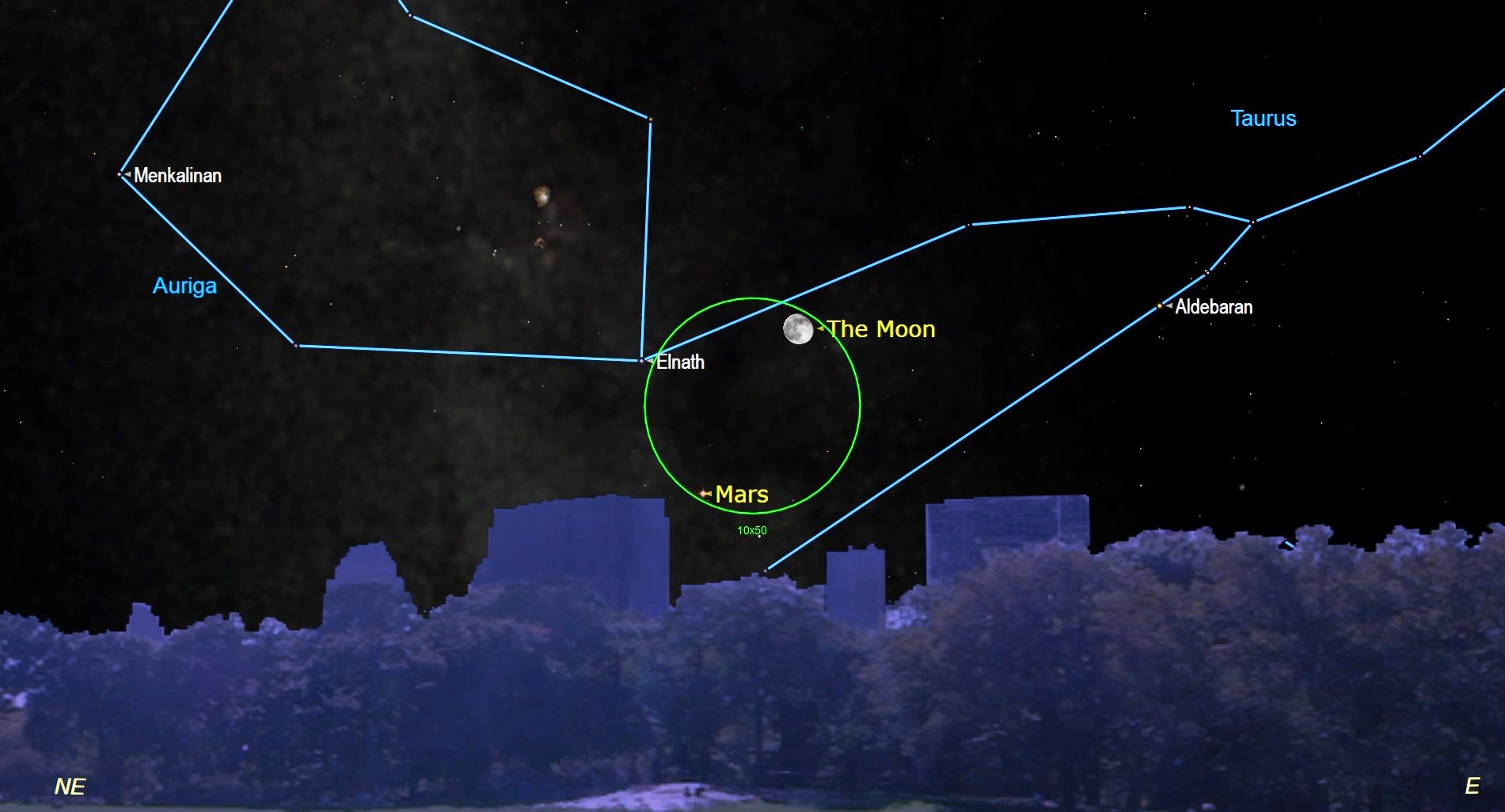Watch the moon visit Mars in the sky Friday night (Nov. 11)
The moon and Mars will make a close approach and will be visible together through binoculars.

On Friday (Nov. 11), the moon will share the same right ascension in an arrangement called a conjunction.
As the 17-day-old moon passes two degrees to the north of the Red Planet, the two astronomical bodies will also make a close approach in the sky. These close approaches of celestial bodies that don't result in an eclipse or an occultation are called an appulse.
The conjunction of Mars and the moon will begin at 8:46 a.m. EST (1346 GMT) and will become visible in the sky over New York at around 7:25 p.m. EST (0025 GMT on Nov. 12) according to In The Sky. The conjunction will be at an altitude of seven degrees above the horizon to the northeast at this time. (Remember: If you hold your fist out at arm's length, its width will correspond to roughly 10 degrees in the sky.)
Related: Night sky, November 2022: What you can see tonight [maps]
The conjunction of the moon and Mars will reach its highest point in the sky, 73 degrees above the southern horizon, at 2:09 a.m. EST (0709 GMT) on Saturday morning. The conjunction will disappear in the dawn twilight at around 6:17 a.m. EST (1117 GMT) when the moon and Mars are 36 degrees above the horizon in the west.
During the conjunction, the moon and Mars will appear to be in the constellation Taurus, the Bull, and will have a right ascension of 05h34m40s.
The moon will have a magnitude of -12.5 and Mars a magnitude of -1.5, with the minus prefix indicating particularly bright objects in the sky over Earth.
Get the Space.com Newsletter
Breaking space news, the latest updates on rocket launches, skywatching events and more!
The moon and Mars will be too widely separated during the conjunction for the arrangement to be visible with a telescope. It will be observable with binoculars or with the naked eye in favorable viewing conditions, however.

Looking for a telescope to see the moon, Jupiter, or any other fascinating thing in the sky? We recommend the Celestron Astro Fi 102as the top pick in our best beginner's telescope guide.
The fourth planet from the sun, Mars is one of the five brightest planets that can be seen with the naked eye over Earth. The other four most visible planets are the solar system's largest planets, the gas giants Jupiter and Saturn, and the two planets closest to the sun and inside Earth's orbit, Venus and Mercury.
These five planets are visible for most of the year, barring brief periods when they are too close to the sun to be seen. It is rare that all of these planets will be visible at the same time on a single night, however.
On the final day of November, skywatchers will get another good opportunity to view Mars when the Red Planet moves to its closest point to Earth, causing it to increase in size and brightness. The two planets are separated by around 50 million miles (80 million kilometers), just over half the distance between the Earth and the sun.
Editor's Note: If you snap a photo of the moon and Mars in conjunction and would like to share it with Space.com's readers, send your photo(s), comments, and your name and location to spacephotos@space.com.
Follow us on Twitter @Spacedotcom or on Facebook.
Join our Space Forums to keep talking space on the latest missions, night sky and more! And if you have a news tip, correction or comment, let us know at: community@space.com.

Robert Lea is a science journalist in the U.K. whose articles have been published in Physics World, New Scientist, Astronomy Magazine, All About Space, Newsweek and ZME Science. He also writes about science communication for Elsevier and the European Journal of Physics. Rob holds a bachelor of science degree in physics and astronomy from the U.K.’s Open University. Follow him on Twitter @sciencef1rst.









